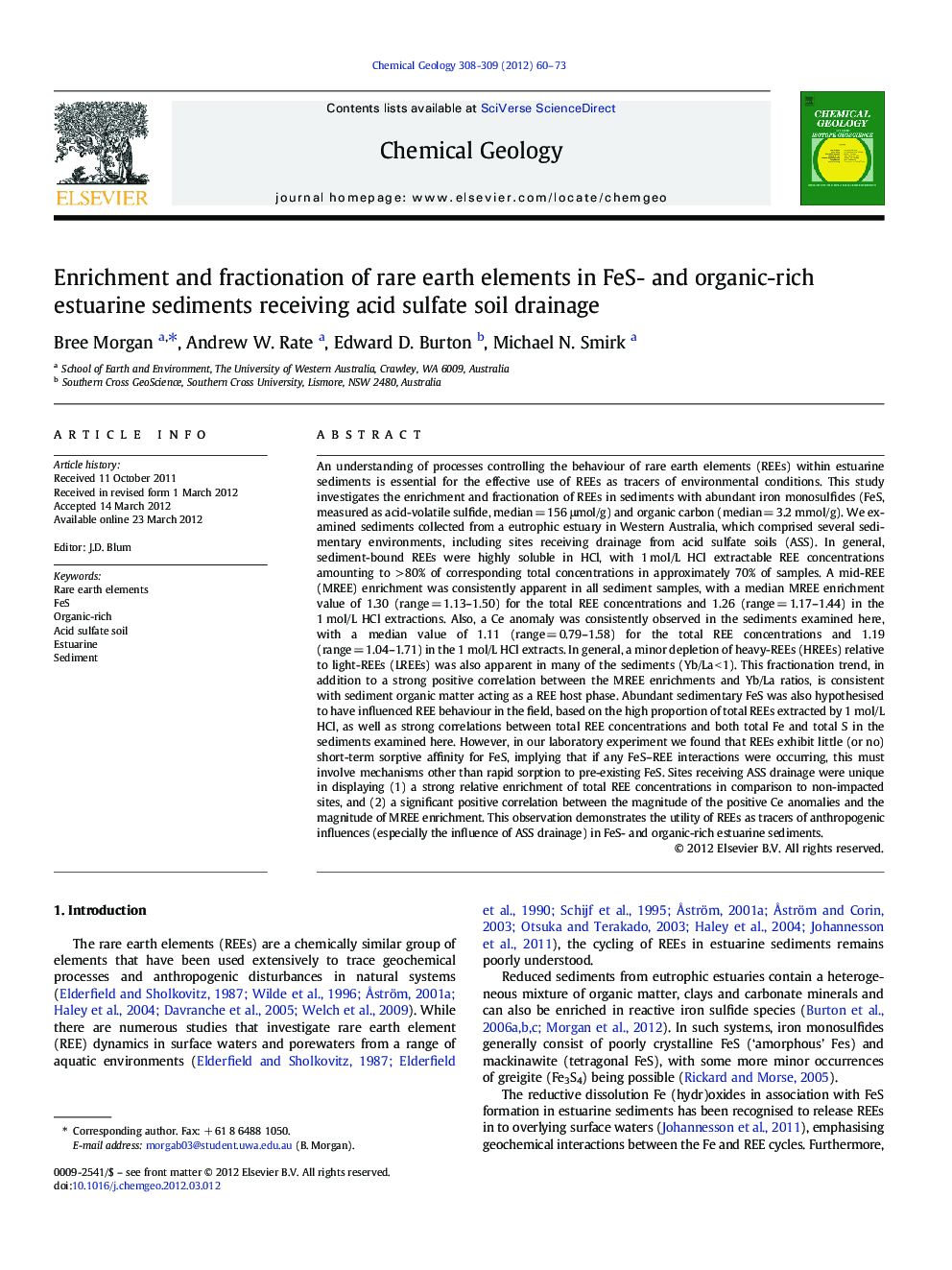| کد مقاله | کد نشریه | سال انتشار | مقاله انگلیسی | نسخه تمام متن |
|---|---|---|---|---|
| 4699447 | 1637646 | 2012 | 14 صفحه PDF | دانلود رایگان |

An understanding of processes controlling the behaviour of rare earth elements (REEs) within estuarine sediments is essential for the effective use of REEs as tracers of environmental conditions. This study investigates the enrichment and fractionation of REEs in sediments with abundant iron monosulfides (FeS, measured as acid-volatile sulfide, median = 156 μmol/g) and organic carbon (median = 3.2 mmol/g). We examined sediments collected from a eutrophic estuary in Western Australia, which comprised several sedimentary environments, including sites receiving drainage from acid sulfate soils (ASS). In general, sediment-bound REEs were highly soluble in HCl, with 1 mol/L HCl extractable REE concentrations amounting to > 80% of corresponding total concentrations in approximately 70% of samples. A mid-REE (MREE) enrichment was consistently apparent in all sediment samples, with a median MREE enrichment value of 1.30 (range = 1.13–1.50) for the total REE concentrations and 1.26 (range = 1.17–1.44) in the 1 mol/L HCl extractions. Also, a Ce anomaly was consistently observed in the sediments examined here, with a median value of 1.11 (range = 0.79–1.58) for the total REE concentrations and 1.19 (range = 1.04–1.71) in the 1 mol/L HCl extracts. In general, a minor depletion of heavy-REEs (HREEs) relative to light-REEs (LREEs) was also apparent in many of the sediments (Yb/La < 1). This fractionation trend, in addition to a strong positive correlation between the MREE enrichments and Yb/La ratios, is consistent with sediment organic matter acting as a REE host phase. Abundant sedimentary FeS was also hypothesised to have influenced REE behaviour in the field, based on the high proportion of total REEs extracted by 1 mol/L HCl, as well as strong correlations between total REE concentrations and both total Fe and total S in the sediments examined here. However, in our laboratory experiment we found that REEs exhibit little (or no) short-term sorptive affinity for FeS, implying that if any FeS–REE interactions were occurring, this must involve mechanisms other than rapid sorption to pre-existing FeS. Sites receiving ASS drainage were unique in displaying (1) a strong relative enrichment of total REE concentrations in comparison to non-impacted sites, and (2) a significant positive correlation between the magnitude of the positive Ce anomalies and the magnitude of MREE enrichment. This observation demonstrates the utility of REEs as tracers of anthropogenic influences (especially the influence of ASS drainage) in FeS- and organic-rich estuarine sediments.
► REE dynamics in FeS- and organic C-rich estuarine sediments are poorly investigated.
► REE enrichments were observed in sediments receiving acid sulfate soil drainage.
► Sediment-bound REEs were highly soluble in 1 M HCl extractions.
► REE fractionation was consistent with a role of organic C in sediment REE retention.
► No conclusive evidence to show FeS retains REEs in estuarine sediments.
Journal: Chemical Geology - Volumes 308–309, 20 May 2012, Pages 60–73